Birds
Media

Species Types
Scientific Name
Quiscalus quiscula
Description
The common grackle makes “a mistake . . . in trying to sing,” a prominent birder once wrote of its kree-del-eeeeks and chlacks. Yet its iridescent purples, blues, and bronzes please the viewer despite the harshness of the voice.
Media
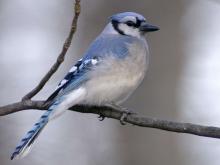
Species Types
Scientific Name
Cyanocitta cristata
Description
Blue jays are notable for their loud voices, blue and white plumage, strong black bill, relatively large size and the distinctive crest atop their heads.
Media

Species Types
Scientific Name
Sitta carolinensis
Description
White-breasted nuthatches, the upside-down birds, creep up and down tree trunks and on the tops and bottoms of branches. The call is a nasal “yank” or “yank-yank.”
Media

Species Types
Scientific Name
Passerina cyanea
Description
One of the most colorful birds in Missouri, the indigo bunting is frequently seen flying up from gravel roads. It is one of the most abundant and easily seen and heard birds in the state.
Media
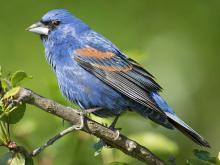
Species Types
Scientific Name
Passerina caerulea (formerly Guiraca caerulea)
Description
The male blue grosbeak is one of Missouri’s most colorful birds, but it is uncommon. To see one, learn to recognize its voice, and visit likely habitats in the Ozarks, May–September.
Media
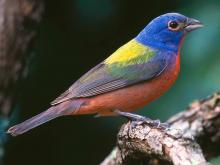
Species Types
Scientific Name
Passerina ciris
Description
The male painted bunting is one of the most colorful birds in North America, with its blue head, red underparts, and green back. Look for it in tangles and thickets in the southwest part of our state.
Media
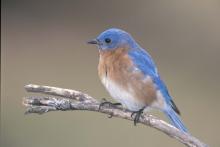
Species Types
Scientific Name
Sialia sialis
Description
The eastern bluebird is the state bird of Missouri. Many say its song sounds like “Cheer cheerful charmer.” The male has blue upperparts and rusty and white underparts.
Media

Species Types
Scientific Name
Melanerpes erythrocephalus
Description
A flurry of black-and-white wingbeats and a bright, all-red head announce the presence of the red-headed woodpecker. The voice is a loud, descending “kweeer.”
Media
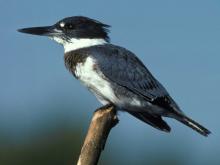
Species Types
Scientific Name
Megaceryle alcyon (formerly Ceryle alcyon)
Description
Belted kingfishers have a big head with a shaggy crest, a long, sharp bill, and a short tail. They perch or hover along rivers and shores, then plunge in to catch fish. The call is a loud rattle.
Media
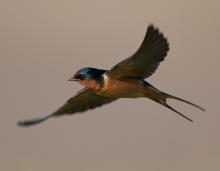
Species Types
Scientific Name
Hirundo rustica
Description
Streamlined, agile fliers with forked tails, barn swallows build cup-shaped nests out of mud affixed to protected areas on the walls of barns and under bridges.
See Also







Media

Species Types
Scientific Name
Hemaris diffinis
Description
The snowberry clearwing is a moth that confuses people because it looks like a bumblebee and flies like a hummingbird!
Media

Species Types
Scientific Name
Hyles lineata
Description
The white-lined sphinx moth sometimes confuses people because it flies, hovers, and eats from flowers like a hummingbird. The adults often fly during daylight hours as well as in the night and are often found at lights.
Media

Species Types
Scientific Name
Darapsa myron
Description
The Virginia creeper sphinx moth is common in woods and brushy areas and comes to lights at night. The larvae eat Virginia creeper and grape leaves.
Media

Species Types
Scientific Name
Perimyotis subflavus (formerly Pipistrellus subflavus)
Description
Tri-colored bats, formerly called eastern pipistrelles, are relatively small and look pale yellowish or pale reddish brown. The main hairs are dark gray at the base, broadly banded with yellowish brown, and tipped with dark brown.
Media

Species Types
Scientific Name
Myotis grisescens
Description
Gray myotises are difficult to distinguish from other mouse-eared bats. A key identifying feature of the gray myotis is that its wing is attached to the ankle and not at the base of the toes. It’s an endangered species.
Media

Species Types
Scientific Name
Myotis lucifugus
Description
The little brown myotis (little brown bat) is one of our most common bats, but populations are declining. White-nose syndrome has taken a heavy toll in northeastern states. This species is now listed as vulnerable across its range.
Media

Species Types
Scientific Name
Myotis sodalis
Description
The Indiana myotis, or Indiana bat, summers along streams and rivers in north Missouri, raising its young under the bark of certain trees. It is an endangered species.
About Birds in Missouri
About 350 species of birds are likely to be seen in Missouri, though nearly 400 have been recorded within our borders. Most people know a bird when they see one — it has feathers, wings, and a bill. Birds are warm-blooded, and most species can fly. Many migrate hundreds or thousands of miles. Birds lay hard-shelled eggs (often in a nest), and the parents care for the young. Many communicate with songs and calls.





















